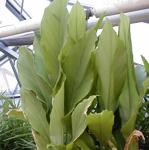ArRest Database
We have a new PAVE interface for the ArREST database, as well as a new assembly.
Click here to access the old assembly and older interface to the ginger and turmeric Aromatic Rhizome EST database.
We have also finished our large scale microarray experiment with ginger and turmeric plants from different developmental stages. Results from these experiments are accessible through NCBI’s GEO site under accession GPL8746. Please check it out!
The microarrays used in this experiment were designed by us but produced by Agilent. They are available to purchase through Agilent’s eArray site. Just click on the species pull down menu on that site to find the Z. Officinale/C. Longa (ginger/turmeric) microarray. The design of the array is available and you can purchase the arrays through this site.
The ArREST database was produced from 8 cDNA libraries from high quality RNA extracted from the rhizome, leaf, and root from both ginger and turmeric. After sequencing random clones from these libraries, we obtained a total of 50,408 ESTs. We have worked with Dr. Cari Soderlund’s group, at the Arizona Genomics Computational Laboratory, to make the ginger and turmeric ESTs available in a database system (called PAVE, for Program for Assembly and Viewing of ESTs) that is easy to work with and analyze. A paper describing the database is currently in revision for publication.
This database is available to the public. We hope that you find the information in this database to be useful.
This database is the first reported major effort to investigate ginger genomics, ginger functional genomics, turmeric genomics and turmeric functional genomics, of Zingiberaceae genomics. It is also a new addition to the growing field of rhizome genomics, which was initiated with work in Sorghum species. We believe that work on ginger and turmeric genomics will be an important addition to our understanding of the genomes of plants.
In addition, we are putting together a new web site dedicated to genes and proteins expressed in plant rhizomes: www.plant-rhizome.org. The goals of this new web site are to 1) encourage community interaction and collaboration in research on plant rhizomes, 2) produce an easily accessible and curated database of genes that are important for rhizome development and function, and 3) educate the public (both lay and scientific) about the importance of rhizomes to their health, nutrition and food supply (both as direct contributors to the food supply as well as competitors, as is the case for many weedy species). Right now the initial site has a list of proteins actually demonstrated as being identified from rhizomes. Surprisingly, only 45 proteins (many of these are the same protein from different species and were used in phylogenetics studies) have been identified from this important plant organ. There is definitely more to do in this area!
For comments or suggestions, please contact Dr. David Gang.
We gratefully acknowledge the National Science Foundation (Grant DBI-0227618) for support of this project.
